It Depends on the Roof Type. Roofing Costs vary because there are many different roof types in Arizona that will affect how much should pay a roofer to do your roof.
Each type of roof has a different price tag attached to it. In this blog, we will explore the prices of each type of roof available in Arizona to figure out how much you should pay a roofer.
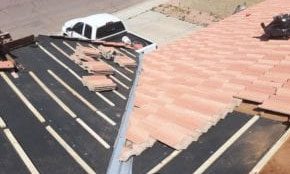
Let’s look at how much you should pay a roofer for a concrete tile roof. A Concrete Tile roof per square (or per 100 square feet) costs $400 to $700 per square for an “R and R” (to remove the tile and replace the existing tile underlayment and reuse the same roof tiles).
'Reusing the same tile is a cost-effective way to replace your roof.
On average, a tile “R and R” for a whole roof costs $7,000 to $15,000 it heavily depending on the size of your roof in Arizona.
Note: this is just an average of how much you should pay a roofer to do your tile roof.
However, some tile brands are brittle and all the tiles need to be replaced which means you will have to pay your roofer more.
In the event that all of the tiles needs to be replaced on your roof the cost per square generally costs:
These prices are supposed to be used as a general guide only on how much you should pay a roofer. Each tile roof varies in size and complexity.
For example, a roof with a larger square area is generally cheaper per square because you get “economies of scale”.
Complexity plays a part in the cost of a new tile roof as well. A roof that is is considered complex has many valleys, different slopes, or angled ridges.
Another price factor is the roofing company you choose. This can make up to a 50% difference in how much you should expect to pay a roofer.
There are many unlicensed “companies” that have rock bottom prices. But should never be an option because they end up usually costing the customer more money when they have to hire a reputable company to fix their roof.
The price range among the roofing companies can vary greatly. For example, our salesman has placed a bid on a job for $15,000.00 and another company had placed a bid for $30,000.00!
The last factor that affects concrete tile roof prices is the quality of the material.
Usually only affects the price by a few hundred to thousands on how much you should pay a roofer (depending on the size of the job). We strongly recommend the best materials to our customers since the ROI is what we focus on.
Using “better” material makes the tile roof last up to 5 to 10 years longer and is worth the extra money!
Let’s look at how much you should pay a roofer for a shingle roof. Shingle roofs are known as the “economical” roof in Arizona.
They are the cheapest roof systems available and last up to 20 to 30 years. They are a great option for “getting the most bang for your buck”.
On an average roof to tear off the existing shingles and install new ones one could expect to pay $7,000 to $15,000.
Note: this is just an average price on how much you should pay a roofer to do your shingle roof.
There are different types of shingles and qualities. The main types in Arizona are Three-tab and Architectural.
Three-tab shingles are a cheaper option than Architectural shingles yet do not last as long (5-7 years less) Usually the price difference between the two is a few hundred for the whole roof.
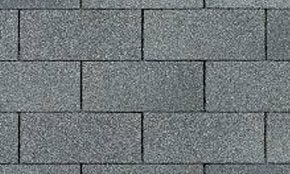
THREE-TAB
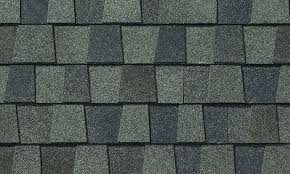
ARCHITECTURAL
Size and complexity play a part in the price as well on how how much you should pay a roofer on a shingle roof.
If the slope of the roof is steeper than 6/12 (6 inches drop over a 12-inch section) then the price will be higher since there is more labor involved. If there are many roof vents that affect the price as well.
Beware of the companies that charge rock bottom prices the shingle market has a low price barrier to enter so there are more unskilled companies that cut corners.
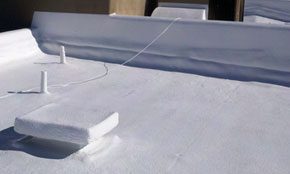
Let’s look at how much you should pay a roofer for a foam roof. Foam roofs are one of the most expensive roofing systems in Arizona but are considered the best option for flat roofs. It has the best insulating properties of any other roof system available on the market.
It is generally $400 to $700 a square. So on average roof size, a new foam roof is around $10,000 to $15,000. Note: this is a general rule of thumb on how much you should pay a roofer to foam your roof.
However, this is not factoring in tearing off the original roof which will vary in cost. Also, a foam roof needs to be re-coated every 5 to 10 years but will last a lifetime if this is done.
So it is important to keep this in mind when thinking about how much you should pay a roofer to install a foam roof.
We’re guessing if you are reading this blog, you likely either already have a leaking concrete tile roof or you have one that is old and likely to begin leaking soon. Read on for tips on how to detect leaks in concrete tiles roofs and what the importance of replacing the underlayment is once it goes bad.
The underlayment that’s used on concrete roofs will typically last you around 20-30 years, although it is heavily dependent on what kind of material was used. Most of the track-style homes across the valley use 30# underlayment, which is the thinnest underlayment allowed according to roofing code, and will last approximately 20-25 years.
If you know that your roof is approaching this age, or is over 20 years old already, then there’s a good chance leaks will start to show up sooner than later. Many leaks go undetected until it’s too late, especially if they are found in harder to see locations like on the eves or gable edges of a roof. A good sign that there’s a leak is to walk around the base of your roof and look upwards at the underside – any signs of water staining are an immediate sign you should have your roof checked.
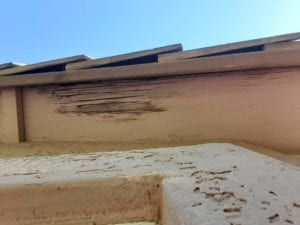
Being proactive means that you are acting in advance before damages are done. Rather than be reactive when fixing your roof, having a proper maintenance plan in place can greatly reduce the effects caused by unseen damages. Things this will help to avoid include dry wall repairs caused by leaks, repainting stained ceilings, removal of mold and still water, and more.
To give an idea of what replacing concrete tile roof underlayment may look like, we’ve included some pictures from a smaller repair. Remember, when it comes to your roof, repairs should be made quickly before the damage is too late to fix!
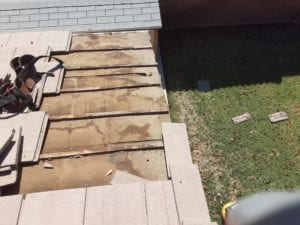
1. Concrete roof tiles are removed:
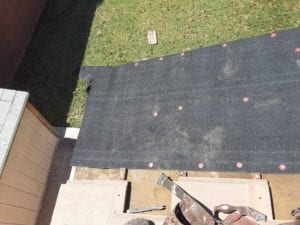
2. Remove Battens strips , clean surface free of debris and install tile underlayment:

3. Install new Batten Strips:
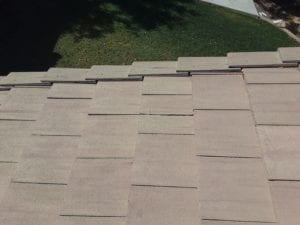
4. Reinstall roof tiles and replace any broken ones:
Before hiring a roof replacement contractor, the NRCA (National Roofing Contractors Association) recommends checking that its crew members are licensed and insured. Ask the roofer to produce a copy of their proof of insurance.
The contractor may also need to pull permits depending on the city you live in, which can add several hundred dollars onto the estimate. As an example, a permit to replace a roof on a 1,350-square-foot home can cost between $150 and $500.
| Roof Size | House Size | Average Roof Replacement Cost |
|---|---|---|
| 1,000 sq.ft. | 667 sq.ft. | $3,500 - $9,000 |
| 1,200 sq.ft. | 800 sq.ft. | $4,200 - $10,800 |
| 1,350 sq.ft. | 900 sq.ft. | $4,725 - $12,150 |
| 1,500 sq.ft. | 1,000 sq.ft. | $5,250 - $13,500 |
| 2,000 sq.ft. | 1,333 sq.ft. | $7,000 - $18,000 |
| 2,200 sq.ft. | 1,467 sq.ft. | $7,700 - $19,800 |
| 3,750 sq.ft. | 2,500 sq.ft. | $13,125 - $33,750 |
| 4,500 sq.ft. | 3,000 sq.ft. | $15,750 - $40,500 |
The roof replacement contractor should also be familiar with local building codes, which might include the kinds of shingles or tiles allowed in a particular neighborhood or regulations regarding the underlayment.
Get multiple quotes and don’t be swayed by just the price. An estimate that's too low could be a sign the company isn't operating legally. Check their online reviews. The bottom line is to make sure the contractor has a good reputation.
Most roofers guarantee the work they do, usually for between five and 10 years for their workmanship. This will typically cover leakage or total failure, but won’t cover general wear and tear or damage from storms. Some companies offer 25-year warranties, but those typically apply to specific high-end roof products and require certain installation procedures.
Replacing a roof is one of the biggest and most costly projects a homeowner can take on.
Roofing companies look at a lot of variables to determine the price of a new roof, including its size, pitch, accessibility, and cost of materials. Because of this, prices for a new roof can vary drastically.
The national average range for replacing a roof is between $7,000 and $24,000, with most people paying around $14,000 for replacing 2,000 sq. ft. of architectural shingles on a 2-story home. The project’s low cost is $3,500 for 1,000 sq. ft. of asphalt shingles on a single-story home.
The highest cost can be up to $44,000 for installing 2,000 sq. ft. of slate shingles on a 2-story home with deck reinforcement. This is of 2022
Calls to contractors show that prices can vary from $5,500 to $12,000 to tear off and replace a roof with basic shingles in 2018. Prices can also vary greatly depending on where you live.
Water damage can also factor into the final expense of a roofing project. Usually, you won’t find water damage until after the roofer has removed the roofing materials and the deck is exposed.
If there’s significant water damage, it can change the project from a roof repair to a roof replacement.
Another factor affecting the price is whether your home has chimneys, skylights, or other protrusions.
They will increase the cost and scope of the project, as your roofing contractor will need to work around them. The cost of repairing flashing around a chimney can range from $500 to $1000 while repairing it around the skylight can average between $500 and $1000.
You might be able to save some money by overlaying an existing roof, instead of replacing it. But doing this can lower the lifespan of the new roof and could void warranties you'd have on labor and materials.
Here are the main factors:
Roof Size
A roof’s size is the largest cost factor. Roofers charge per roofing square. A 10-by-10-foot (100 square feet) area is equal to one roofing square. So, a 3000 sq. ft roof is equal to 30 squares.
Pitch of the Roof
Another variable in pricing is the pitch of the roof or the slope. Some roofs have a high pitch, while others have a low pitch or no pitch at all — all factors which affect the cost of the roofing estimate.
A roof with a pitch of about a 7:12 ratio — the first number represents the height and the second the length — or higher isn’t walkable and will probably require more safety harnesses and equipment. A 7:12 roof, as an example, means that for every 12 inches it runs horizontally, the roof rises 7 inches vertically.
A roof of 7:12 or greater is a pretty steep roof, and roof replacement contractors will charge more to work on this type of roof. The work goes more slowly with a steep roof.
You can’t stack materials on the roof, and crew members will need to wear harnesses. Because of these difficulties and because the roofing company will pay more in insurance costs, their quote is adjusted accordingly.
| Pitch | Average Replacement Costs per Sq.Ft. (Labor Included) |
|---|---|
| Flat | $4.50 - $7 |
| Low Slope | $4.50 - $7 |
| Conventional Slope | $3.50 - $9 |
| Steep Slope | $5 - $12 |
Accessibility to the Roof
Can the roofer get a truck close to the house? Can they back the truck up against the house? If not, they’ll have to carry the materials to and from the trucks. That will cause more costs for the roofing contractor and will make the project more expensive. Tearing off a heavier roof can also increase labor costs.
Type of Roofing Material
It costs from $3 - $6 a square foot to remove and replace the roof or $6,00-$12,000 for 2,000 Sq.Ft.Roof.
square foot ranch-style home, with a gentle slope, on average. The cost and labor for an asphalt roof for a 1,200-square-foot house in larger markets across the country range between $4,500 and $7,000. Asphalt is the most affordable roofing option, followed by wood, metal, tile, and slate.
| Material | Cost per Sq.Ft. (Labor Included) | Cost for a 2,000 Sq.Ft. Roof |
|---|---|---|
| Asphalt Shingle | $3 - $6 | $6,000 - $12,000 |
| Vinyl (PVC) | $3 - $8 | $6,000 - $16,000 |
| Plastic | $3 - $8 | $6,000 - $16,000 |
| Bitumen | $4 - $8 | $8,000 - $16,000 |
| Concrete Tile | $4 - $20 | $8,000 - $40,000 |
| Metal | $4 - $30 | $8,000 - $60,000 |
| Rubber | $5 - $13 | $10,000 - $26,000 |
| Architectural Shingles | $7 - $15 | $14,000 - $30,000 |
| Cedar | $8 - $12 | $16,000 - $24,000 |
| Composite | $8 - $15 | $16,000 - $30,000 |
| Clay | $10 - $25 | $20,000 - $50,000 |
| Green | $10 - $35 | $20,000 - $70,000 |
| Solar | $12 - $25 | $24,000 - $50,000 |
| Slate | $15 - $25 | $30,000 - $50,000 |
The cost per square foot for a wood shingle roof is between $8 and $12. That equates to about $16,00 to $24,00 per 2,000 square feet, which is twenty squares.
Materials for a metal roof can cost upwards of $800 per 2,000 square feet. The price can be twice as much for a metal roof compared to asphalt shingles, and as much as four or five times more for slate.
While good asphalt shingles may last 20 or more years, metal, tile, and slate may last 30 or more years, which can play a role in determining the type of roof you ultimately choose.
The material prices for roofing and construction have gone up dramatically in the last few years. We have seen it trickle across many industries including property management. Roof maintenance costs and other common home maintenance costs have gone up. This is because companies are raising their prices to adjust for inflation and rising material costs.
The Local Experts From SGI | Phoenix AZ | Property Management
Mikku and Sons Roofing (623) 465-1068 provides quality roof replacement, roof installation, and roof repair services to Phoenix AZ, and the surrounding Phoenix communities. We’ve been a reputable, quality roofing contractor since 2001. If you need honest advice regarding your roofing project, give us a call.
Is it time to replace the roof on your house or commercial building? If you are, there’s some do’s and don’t’s that you’ll want to remember. Having an intact roof that your property can rely on is critical, as it’s the first defense against severe storms. The following roof replacement tips are essential when making this decision.
If you don’t know your the condition your roof is in, you can look for several different warning signs. Look to see if there are any signs of water damage or spots that are leaking. Are there any spots where it looks like its sagging? Can you detect any outside light shining through in the attic? Are there any dark spots or water trails that show?
How do you know when to repair or replace your roof? When do roof leaks become too expensive?
The lifespan of your roof depends on the materials used when its built. Usually, shingles have a life expectancy of 20-30 years (depending on the quality of the shingles you choose), while a foam roof, properly maintained, can last up to 50 years.
Of course, we have additional factors that come in to play in the Southwest. The heat, and especially the hot sun, are the main reasons for natural aging, and southern exposures usually have the most wear and tear. Wind, hail, bad drainage, tree branches, pollution and weather extremes also contribute to the aging of a roof. Of course, the easiest way to avoid having a roof replaced is to take care of the materials and fix any found damages right away.
If you’re questioning whether to repair or replace your roof, here are 10 signs to watch for that might be an indication that it’s time for a roof replacement:
If you answered yes to some of these, then you need to compare the expenses involved. If you figure the amount to repair the roof will be $2,500 and will last five years, when it will need to be repeated. Compare that to the cost of a new roof that will need only routine maintenance and could last up to 30 years. It might make more sense to spend the money now and save a larger amount of money later in future repair expenses.
However, be careful, you need to be aware that putting off a roof replacement can cost you more down the road. Poor maintenance routines can allow moisture to penetrate the membrane and cause damage to your insulations and roof deck. If you need to replace these along with roof materials you will have a much bigger roofing expense to deal with.
Before choosing a roofing system, a home or business owner needs to know how sturdy the roof structure is and what kind of weight load it can handle. For example, not all building structures are designed to handle the weight of ceramic or concrete tiles. In addition, the pitch and size of the roof may play a factor in selecting materials. Once the weight limit, size and pitch are known, then the choice of appropriate materials can be made. Here are some things home and business owners should think about when making a choice.
Clay, terracotta, slate and concrete tile roofing materials are very common throughout the southwest, particularly in the Phoenix area. This type of material holds up well to the extreme weather conditions in Arizona and is particularly impact-resistant to falling debris and hail. This is an important factor to consider when choosing a roofing system. It also allows a certain amount of air circulation up under the tiles, helping to keep your roof cooler in the heat. Since it comes in a variety of colors and shapes, it is also extremely attractive. However, the weight may be a factor when selecting this type of material.
Foam roofing is most often used on flat surfaces, but thanks to its ability to flow when it is applied, foam can be put on almost any type of roof surface. With proper maintenance (every 10-15 years) this material can last more than 50 years. Foam roofs are also very light weight, much more so than more traditional roofing material options. It is also durable, impact resistant and very energy efficient. Foam roofing frequently produces an energy savings of 30% or greater when compared to the alternative roofing systems.
Standard asphalt shingles have three tabs and tend to have a repetitive pattern from one home or business to the next, although they do come in a variety of colors. In contrast, dimensional shingles, also known as architectural or laminated shingles, have two layers of shingle material bonded together, but random notches have been taken out, exposing the bottom layer. This gives these new shingles a three dimensional look to the roof, with different high and low tabs. Because of the double bonded layer, dimensional shingles actually offer more protection and impact resistance from wind and hail — with the heaviest grades able to withstand 120 mph winds. They also have a longer lifespan — 40 years compared to the average 20 years for the single layer asphalt shingles.
Single ply roofing is one of the fastest growing roofing applications for flat roofs in the world. Widely used in the Southwestern United States, these white-colored roofing systems are highly reflective and energy efficient, often Energy Star rated. Major manufactures including Firestone manufacture this product, and offer 10-30 year warranties. Single Ply roofs also offer creativity in the insulation package that can be installed underneath the membrane, with availability of R-30 and beyond.
During the summer months, most people wear lighter colored clothing because light colors reflect heat and sunlight, whereas dark colors absorb it. Buildings are the same as people. A dark-colored roof will be hotter than a light-colored roof. The term “Cool Roof” refers to roofing materials that reflect the sun’s energy from the roof surface. Cool materials for low-slope roofs are mainly bright white in color, although non-white colors are starting to become available for sloped roof applications.
Cool Roofs must also have high emissivity, allowing them to emit infrared energy. For instance, metal roofing tends to have low emissivity and is not considered a cool material. Cool roofs can reduce the roof surface temperature by up to 100 degrees Fahrenheit, thereby reducing the heat transferred into the building below. This helps to reduce energy costs (by keeping attics and ducts cooler), improve occupant comfort, cut maintenance costs, increase the life cycle of the roof, and reduce urban heat islands along with associated smog.